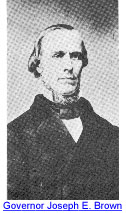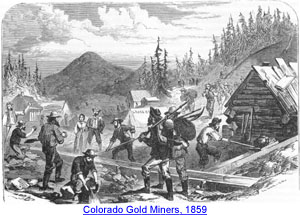

 Unique, "EB on Breast"
Unique, "EB on Breast"1787 Brasher Doubloon from
The Gold Rush Collection
The 1860s
 George Kellogg became the sixth and final superintendent
of the Dahlonega Mint in October 1860. Kellogg was a successful
businessman and former member of the state legislature.
Georgia Governor Joseph Brown described him as "a
Christian, a moralist, a man worthy of imitation. "
Georgia seceded from the Union on January 19, 1861.
George Kellogg became the sixth and final superintendent
of the Dahlonega Mint in October 1860. Kellogg was a successful
businessman and former member of the state legislature.
Georgia Governor Joseph Brown described him as "a
Christian, a moralist, a man worthy of imitation. "
Georgia seceded from the Union on January 19, 1861.
The mint coined 1,597 half eagles dated 1861-D in February; the coinage was duly reported to Philadelphia. Although the working records of the Dahlonega Mint are not extant, it has been estimated by Clair Birdsall that an additional 1,600-1,700 half eagles and 2,750-3,250 gold dollars dated 1861-D

were struck after the February coinage. Although the additional strikings were accomplished by the same personnel who had executed the earlier coinage of half eagles (and not "rebel forces," as is so often stated), the subsequent mintage was not reported to Philadelphia. Dahlonega coins dated 1861 are among the most coveted from this colorful, short-lived mint. It is interesting to note that a significant portion of the gold deposits for 1860 and 1861 came from the Pike's Peak region of Colorado.

In April 1861, Superintendent Kellogg submitted his resignation to U. S. President Abraham Lincoln.
 In the letter he stated, "Georgia has turned all
public property...of the United States over to the Confederate
States Government." On May 14, the Confederate Congress
voted to close the mints at New Orleans and Dahlonega
effective June 1. Although the Confederate government
was petitioned by the townspeople of Dahlonega to keep
the mint open, there is no evidence that additional coinage
took place. Superintendent Kellogg completed the mint
records, shipped approximately $17,000 in gold coins and
$10,000 in uncoined gold and silver to Charleston, and
sold some of the remaining supplies.
In the letter he stated, "Georgia has turned all
public property...of the United States over to the Confederate
States Government." On May 14, the Confederate Congress
voted to close the mints at New Orleans and Dahlonega
effective June 1. Although the Confederate government
was petitioned by the townspeople of Dahlonega to keep
the mint open, there is no evidence that additional coinage
took place. Superintendent Kellogg completed the mint
records, shipped approximately $17,000 in gold coins and
$10,000 in uncoined gold and silver to Charleston, and
sold some of the remaining supplies.

He completed a detailed inventory of mint property, locked the mint records in the vault, and turned the mint building over to a caretaker on June 28. During its 24 calendar years of coinage operations, the Dahlonega Mint had produced just over $6.1 million in gold coins.
The mint facility served as an assay office and repository for the Confederate Treasury during the Civil War. Consideration was given to continuation of the facility in its former capacity, or as an assay office. Accordingly, in the summer of 1865, an inspection of the mint property was made at the request of the United States Treasury Department, with estimates given for its reactivation.